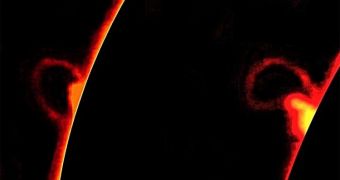In a paper published in the May 16 online issue of the top scientific journal Nature, astronomers propose that Sun-like stars can produce explosions up to 10,000 times more energetic than those that our parent star is known to have ever produced. These phenomena are known as “superflares.”
The same team of experts that authored the paper believes that there is currently no similar danger related to the Sun. A superflare can be between 10 and 10,000 times more energetic than a standard solar flare produced by our star.
These events have been seen on numerous types of stars until now, but it was only recently that scientists had a chance to observe them on G-type yellow dwarfs. Astronomers say that Sun-like stars are cataloged as such if they have comparable temperatures, masses and sizes.
There is no doubt that a superflare would have catastrophic consequences for life on Earth, considering that standard flares have the potential to disturb our planet's magnetic field, fry satellites in orbit and power grids on the ground, and impact the health of astronauts on the International Space Station.
In the new study, experts used data from the NASA Kepler Telescope, which constantly watches the activity of around 150,000 stars in a small patch of the night sky. The observatory kept an eye out for superflares for around 120 days.
Kepler was able to discover 365 superflares from the surfaces of 148 stars. Each of these events lasted between 1 and 12 hours. The team says that only 101 of the superflares were produced by slow-spinning, Sun-like stars, Space reports.
One of the conclusions that can be drawn from this study is that the frequency and intensity of superflares may be directly correlated to a star's rotation speed. This happens because faster-spinning stellar objects exhibit more magnetic activity, thought to be the main source of flares.
The investigation was conducted by astronomers at the Kyoto University, in Japan, who were led by expert and lead study author, Hiroyuki Maehara.
“We need detailed observations – for example, high-resolution spectroscopy – of superflare stars, which allow us to know whether superflare stars are really similar to our Sun,” the expert says.
“Most superflare stars have large starspots, but the present Sun does not. Further studies are necessary to understand why and how such large starspots are formed on solar-type stars, and whether our sun can produce superflares,” he concludes.

 14 DAY TRIAL //
14 DAY TRIAL //